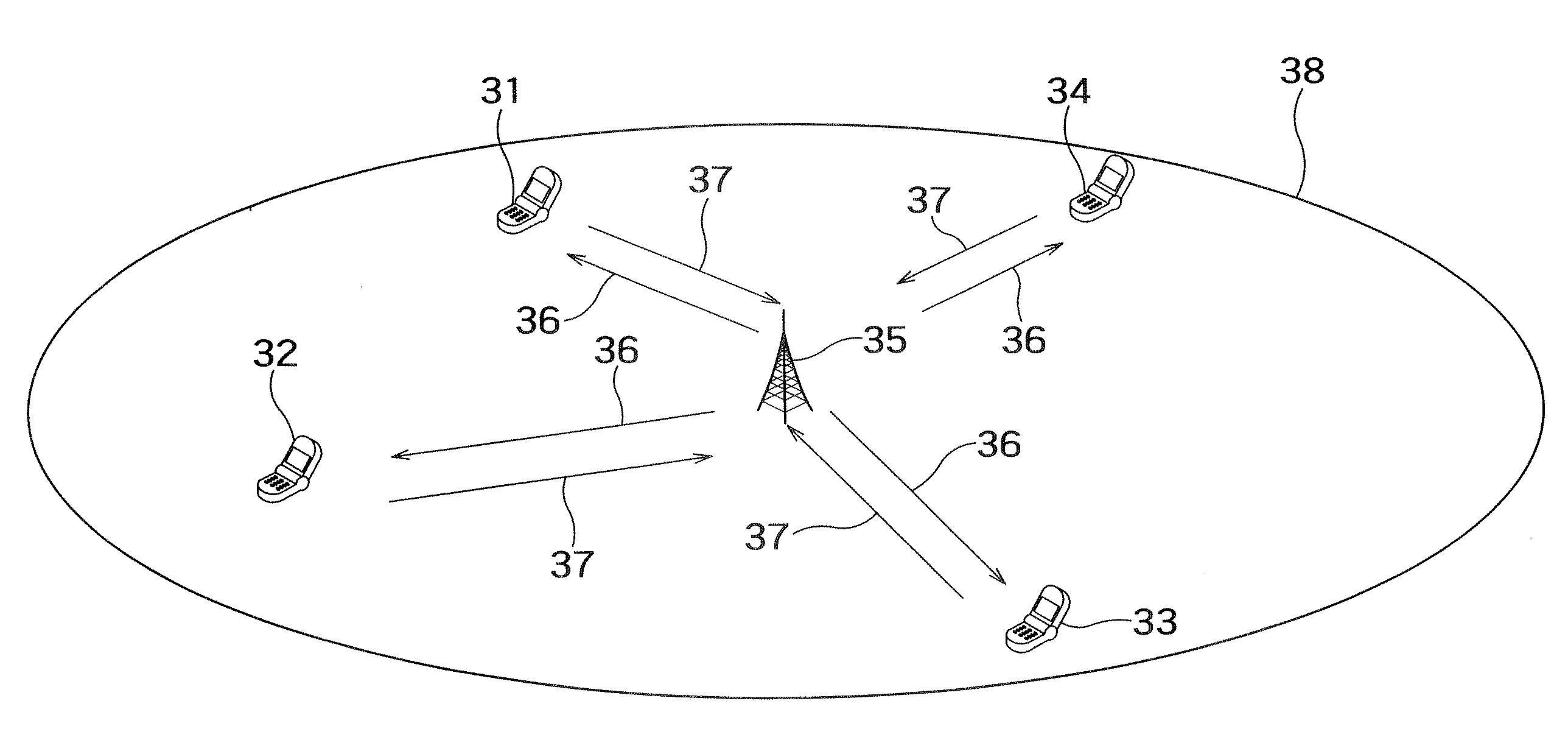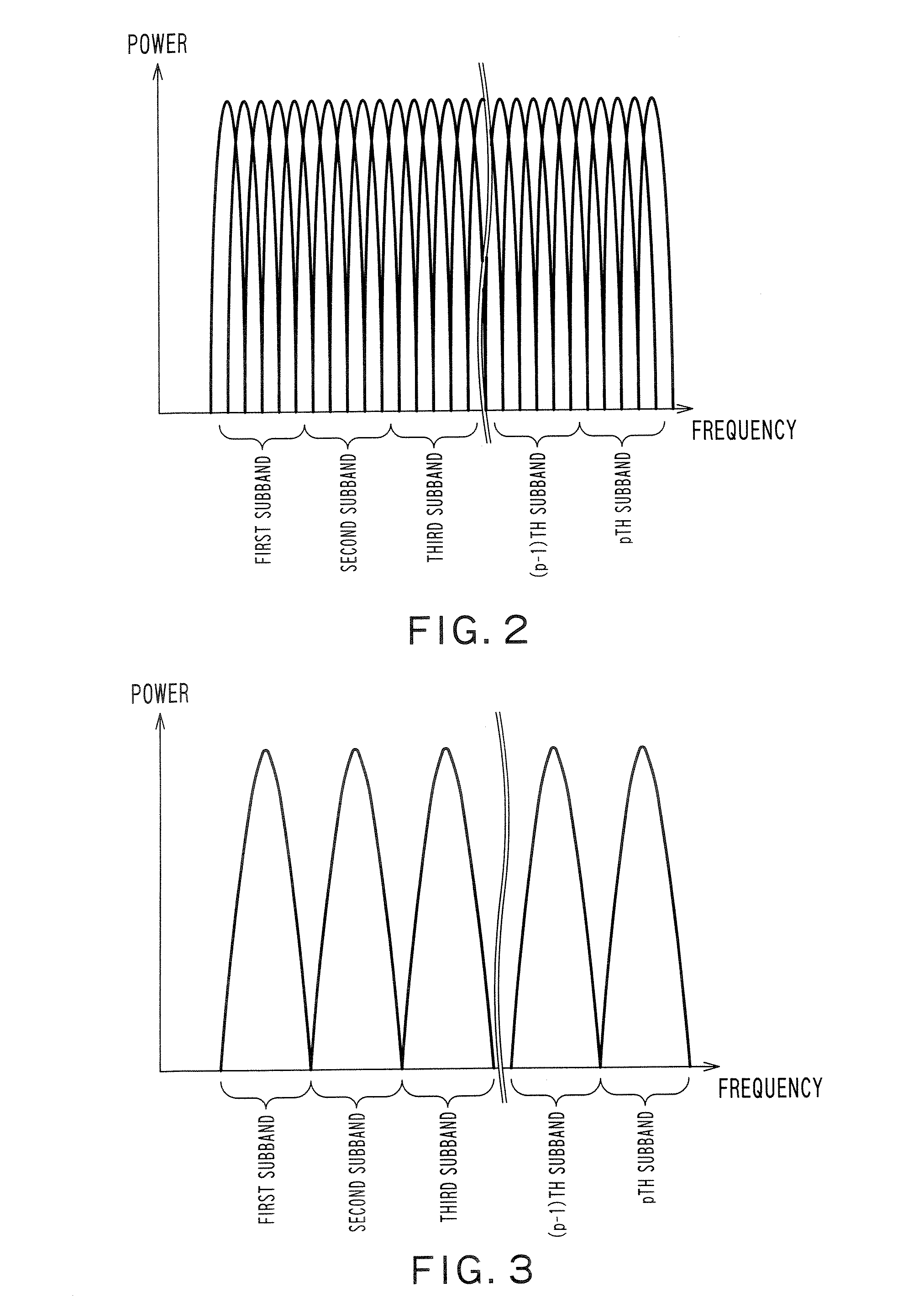Base station, radio terminal and radio communication method
a radio terminal and radio communication technology, applied in the direction of wireless communication, transmission path division, signalling characterisation, etc., can solve the problems of reducing the transmission rate of uplink to the base station, the inability to assign subbands to the terminals, and the amount of information of feedback from the terminal to the base station
- Summary
- Abstract
- Description
- Claims
- Application Information
AI Technical Summary
Benefits of technology
Problems solved by technology
Method used
Image
Examples
first embodiment
[0043]FIG. 1 shows an example of a radio communication system according to this embodiment. This radio communication system includes a base station 35 and a plurality of radio terminals (hereinafter simply referred to as “terminals”) 31, 32, 33 and 34. The terminal 31, terminal 32, terminal 33 and terminal 34 are located within reach of radio signals from the base station 35, that is, within a communication area (cell) 38. Suppose radio signal transmission from the base station 35 to the respective terminals 31 to 34 is called a “downlink 36” and radio signal transmission from the respective terminals 31 to 34 to the base station 35 is called an “uplink 37.”
[0044]Suppose a multicarrier communication scheme such as OFDM (Orthogonal Frequency Division Multiplexing) or multicarrier CDMA (Code Division Multiple Access) is used for the downlink 36. In a multicarrier communication, communication is carried out using a plurality of subcarriers arranged on a frequency domain. An OFDM commun...
second embodiment
[0105]This embodiment will explain CQI feedback by a terminal and scheduling by a base station in detail.
[0106]As explained in the first embodiment, FIG. 10 shows an example of a downlink frame format. One subband includes 15 subcarriers and one subframe includes seven OFDM symbols. The total number of subcarriers is 300 and the total number of subbands is 20. Furthermore, suppose one frame includes a plurality of subframes and assignment of subbands is updated on a frame boundary. Furthermore, suppose the number of subbands required by the terminal for the downlink is four. Suppose the hatching areas in the figure denote subframes to which pilot signals are assigned.
[0107]Furthermore, suppose a base station 35 is communicating with a terminal 31, terminal 32 and terminal 33. Furthermore, suppose the terminal 31 to terminal 33 are currently receiving an mth subframe determined as a CQI generation time. Therefore, each terminal performs channel estimation using pilot signals and furt...
third embodiment
[0117]This embodiment will explain an example of a method of generating CQIs.
[0118]The lower part of FIG. 15 indicates CQIs to be fed back from a terminal to a base station. The upper part of FIG. 15 indicates a reception power of each subband calculated by the terminal. Suppose the terminal sets priority in descending order of reception power. When four CQIs can be fed back simultaneously, CQIs that are fed back first are CQI5, CQI4, CQI13 and CQI3. These CQIs correspond to CQIs of the four frequency channels (Y frequency channels) with high priority.
[0119]Suppose the next CQI to be fed back has quality obtained by averaging communication quality of a plurality of subbands (X frequency channels). For example, suppose each CQI fed back for the second time includes average communication quality obtained by averaging communication quality of two subbands. As a result, it is possible to feed back communication quality corresponding to a total of 8 (=2×4) subbands in the second feedback...
PUM
 Login to View More
Login to View More Abstract
Description
Claims
Application Information
 Login to View More
Login to View More - R&D
- Intellectual Property
- Life Sciences
- Materials
- Tech Scout
- Unparalleled Data Quality
- Higher Quality Content
- 60% Fewer Hallucinations
Browse by: Latest US Patents, China's latest patents, Technical Efficacy Thesaurus, Application Domain, Technology Topic, Popular Technical Reports.
© 2025 PatSnap. All rights reserved.Legal|Privacy policy|Modern Slavery Act Transparency Statement|Sitemap|About US| Contact US: help@patsnap.com



